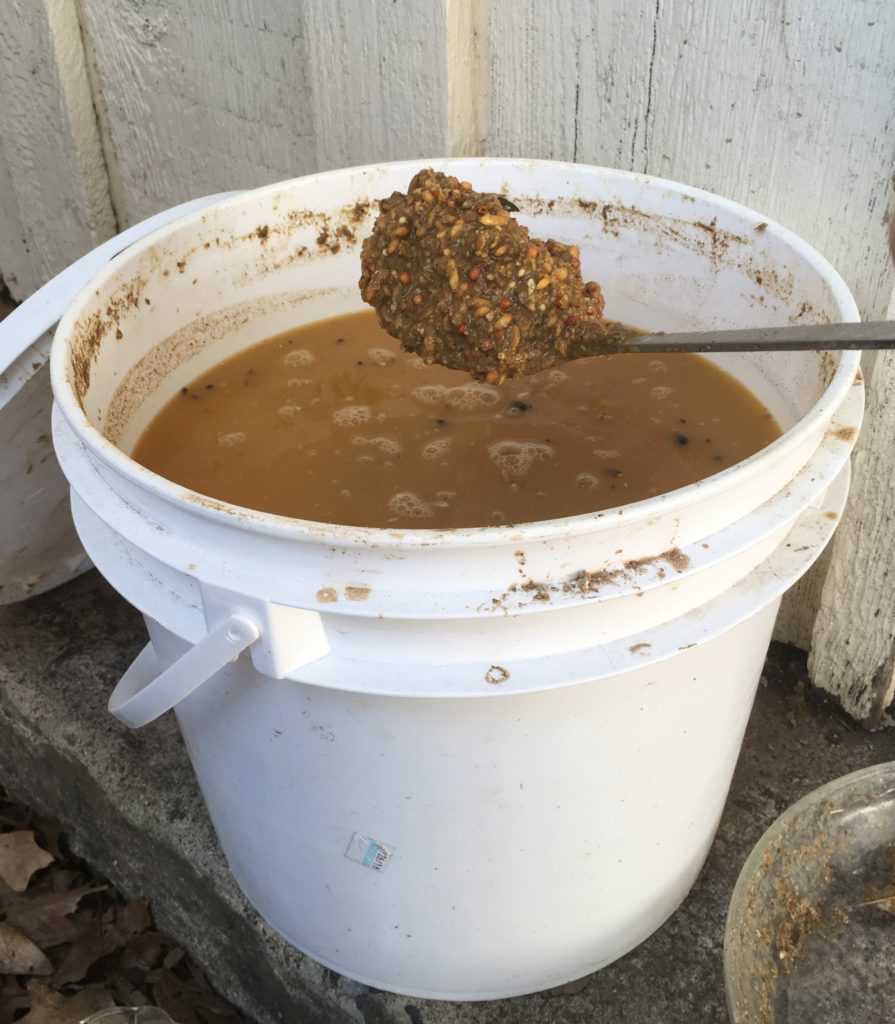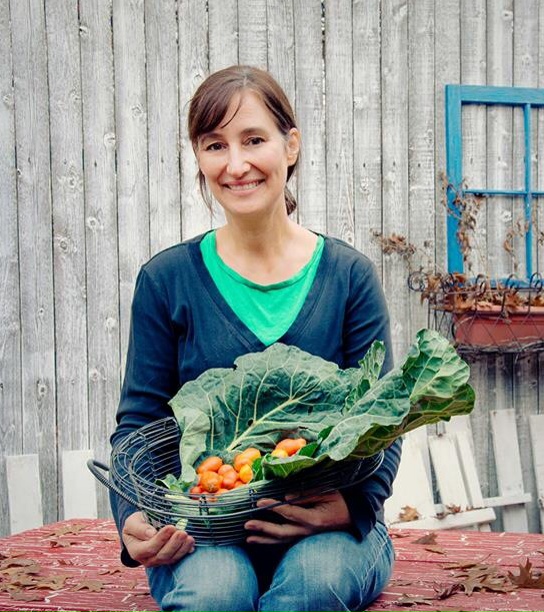Fermenting Feed for Your Flock
By Anne-Marie Miller
 Nothing says spring like getting baby chicks! Our wee puffs of fluff are chirping happily in the garage, toasty warm under a heat lamp. There is just nothing like that sweet sound they make. I am excited to report that I was able to get one of breeds I have been wanting for years: Silver Laced Wyandotte. New chicks mean more fresh eggs in our future.
Nothing says spring like getting baby chicks! Our wee puffs of fluff are chirping happily in the garage, toasty warm under a heat lamp. There is just nothing like that sweet sound they make. I am excited to report that I was able to get one of breeds I have been wanting for years: Silver Laced Wyandotte. New chicks mean more fresh eggs in our future.
Recently, spurred on by my practically minded husband, I started on a quest to reduce the cost of our home raised eggs. Fermenting our chicken feed is one of the major ways I was able to cut the cost of feeding my girls. This process has not only cut down on wasted feed, but fermented feed means my chickens have been able to get more nutrition out of their feed and eat less. Listen closely – that is the sound of money trickling as it falls into my piggy bank!
Turns out seeds have a protective coating on them that makes them hard for chickens, or us for that matter, to digest without first being processed. Fermenting seeds helps break down that protective coating and make the nutrients more easily available. As if that wasn’t enough good news, fermenting can actually create new vitamins, specifically B vitamins and vitamin K, as well as enzymes.
One experiment I read had this to say: “…improved feed conversion as compared with the dry mash… increase egg weight… increase shell weight and stiffness…increase intestinal health by acidification of the upper digestive tract, forming a natural barrier towards infection with acid sensitive pathogens, e.g. E. coli, Salmonella and Campylobacter.”
I think we can all agree that this is valuable stuff! Here is a breakdown on how to make this wonderful fermented feed:
You will need to score a food grade 3 or 5-gallon bucket from your local grocery or bakery. If you have just a few girls, you can use a big glass jar. Just no metal please.
Measure out the amount your chickens will eat in 3 days. Each chicken eats roughly 1/3 cup per day. Put feed into bucket, keeping in mind that it will increase in volume once water is added.
Pour filtered (non-chlorinated) water over feed until it is about 1″ over the feed. I have a rain barrel so I use the water from that. The feed will soak up water therefore increasing in volume, so you might need to come back later that afternoon to add more water. The trick is to keep the feed covered with water so that mold doesn’t form. Give it a good stir every day. Keep it in a warm place. Bubbles coming up are a great sign! It should have a sour smell, which is not unpleasant. If you make your own sauerkraut or kefir you can put a little of the brine or whey into your feed to speed up the process, but it is not necessary. 
On the 3rd day use a slotted spoon to serve it out to your girls. Another way is to spoon it into a pasta strainer with a bucket underneath it to catch the liquid. My girls loved it and licked the bowl clean. However, my friend’s chickens were a bit suspicious for a few days. Don’t give up! They will come around and, when they do, get out of the way!
I serve this delectable entrée in 2 glass pie plates lifted up off the ground with plant pots. I use 2 so that Mrs. Waffles, who is low in the pecking order, will get some. I lift them up on pots so that my girls won’t kick dirt or leaves into them. Yes, you might have to say goodbye to that automatic chicken feeder, but it is a small price to pay.
Everyone has a different way of storing the fermented feed depending on the size of their flock. I use 2- 3 gallon buckets as that allows me to always have some feed fermenting. My friend adds dry feed every time she serves some out of her bucket. I have heard of one farmer fermenting in a large trash can. Boy, I would like to see the size of that flock!
This method has the added benefit of a cleaner chicken yard, which in turn results in less hairy rodents running around. Feed is not kicked around the chicken yard for those undesirable villains to find in the night. Rinsing the serving dishes with the hose at the end of the night and setting them out in preparation for morning is always a good idea. Anything left in the dish at the end of the night should be disposed of. It took a bit of time to figure out how much my girls consumed in the course of a day, but now I have it down.
You can ferment the regular chicken pellets, crumble or whole grains for your chickens. I am doing a mixture of both just to make sure my feathered friends are getting everything they need. My girls have never looked better and their eggs have never been tastier. I am curious if this will help us get through the hot stressful summer here in Dallas, Texas. I also wonder how this would work up North. Would the mixture freeze before the chickens had time to consume it all? If you ferment your chicken feed in the snowy tundra, let us know how it works for you.
Cutting the cost of feed has allowed my practical hubby to get on board with getting more chicks this year. His reasoning is that if we can have better quality eggs at the same price or cheaper than grocery store eggs, then why not? I am comforted that my egg laying hens get to have a good life, out in the sunshine, doing what chickens are supposed to do. So, I get more cute fuzzies this year! Yes, I am fermenting starter feed for these new little ones too. I hope this encourages you to start fermenting for your flock this year. It’s a win-win for everyone!
Source: http://www.ncbi.nlm.nih.gov/pubmed/19373724
Hungry for more? Read the rest of the series:
1. How to Cut the Cost of Raising Your Flock
2. Raising Nutritious Insects
3. Fermenting Feed (currently reading)
4. Growing Greens
 Anne-Marie or Dash (for the hyphen in her name) is an urban farmer in Dallas, Texas. She raises chickens and rabbits on less than ¼ of an acre. Plus, she has turned her front yard into a large stand-out-in-the neighborhood vegetable garden. In addition to the farming she does on her homestead, she helped create a community garden literally from grassy field to thriving garden. What stands out about her little urban homestead is her determined out of the box approach to overcoming obstacles. You can follow her adventures on her little urban homestead by visiting her blog, BloomWhereYourPlanted.com.
Anne-Marie or Dash (for the hyphen in her name) is an urban farmer in Dallas, Texas. She raises chickens and rabbits on less than ¼ of an acre. Plus, she has turned her front yard into a large stand-out-in-the neighborhood vegetable garden. In addition to the farming she does on her homestead, she helped create a community garden literally from grassy field to thriving garden. What stands out about her little urban homestead is her determined out of the box approach to overcoming obstacles. You can follow her adventures on her little urban homestead by visiting her blog, BloomWhereYourPlanted.com.
*Disclosure:
Some of the links in our podcast show notes and blog posts are affiliate links and if you go through them to make a purchase, we will earn a nominal commission at no cost to you. We offer links to items recommended by our podcast guests and guest writers as a service to our audience and these items are not selected because of the commission we receive from your purchases. We know the decision is yours, and whether you decide to buy something is completely up to you.








Hi! We are from TX, too — used to live in the DFW area, in fact — but now farm in eastern Ohio, where the Lord still remembers to send rain. We have been feeding our poultry fermented grains for about four years, summer and winter; the fermentation buckets live in the basement in winter, tightly lidded so we aren’t raising fruit flies too — with twice-daily rations going out to the birds in their unheated (and often below-freezing, even below-zero) living quarters, along with warm drinking water. We keep four flocks of birds: there are the four-year-old Rhode Island Reds, the yearling Buckeyes, six Appleyard ducks with their drakes, and three pairs of Pilgrim geese. All of them get fermented grain as their primary food, with added protein (usually meat scraps) for the regular layers. All do very well on this diet — the four-year-olds are lovely, sleek birds, laying at about 50% right now, in a cold March.
All hail the modern homesteader, of which you appear to be an excellent example!
Shawn and Beth Dougherty
Hi Shawn and Beth, That first Winter must have been a shock moving from DFW! Thank you for giving us a northern perspective! I was so hoping someone would answer that question for us. 4 yr old girls still looking healthy and laying! We must be on to a good thing. Happy Homesteading! Dash
great info!!
i plan to implement this for my flock. how long does the fermented feed (in the 5 gal bucket) last? a week? do you need to dump what hasn’t been eaten after a certain amount of time?
Hi Sherry, I am glad to know you will be giving it a try. I think you will be pleased with the results. Everything that is left in the dishes for the chickens needs to be thrown out at the end of the night, but many people just keep adding to the bucket(very much like a sour dough culture if you have ever done that) So to answer your question; as long as the mixture doesn’t smell foul or you don’t see mold it is o.k. to feed to the flock.
Dash
We do this in Nova Scotia, Canada, I just bring my bucket inside in winter!?
Hey there!
Do you keep a lid on your fermenting feed? Tight lock/full-seal? Or just the regular lid for a 5gal bucket?
Or do you leave it open?